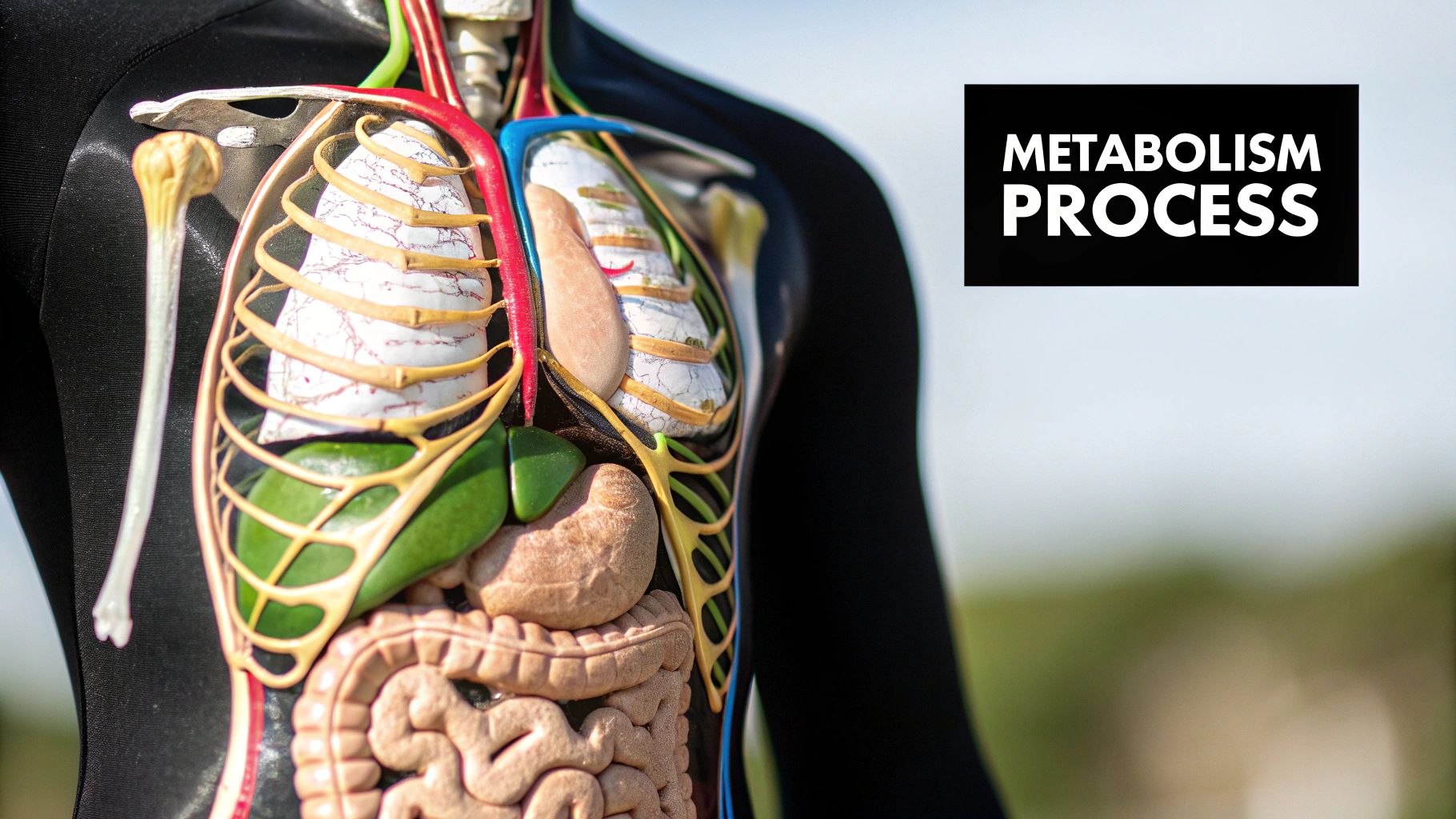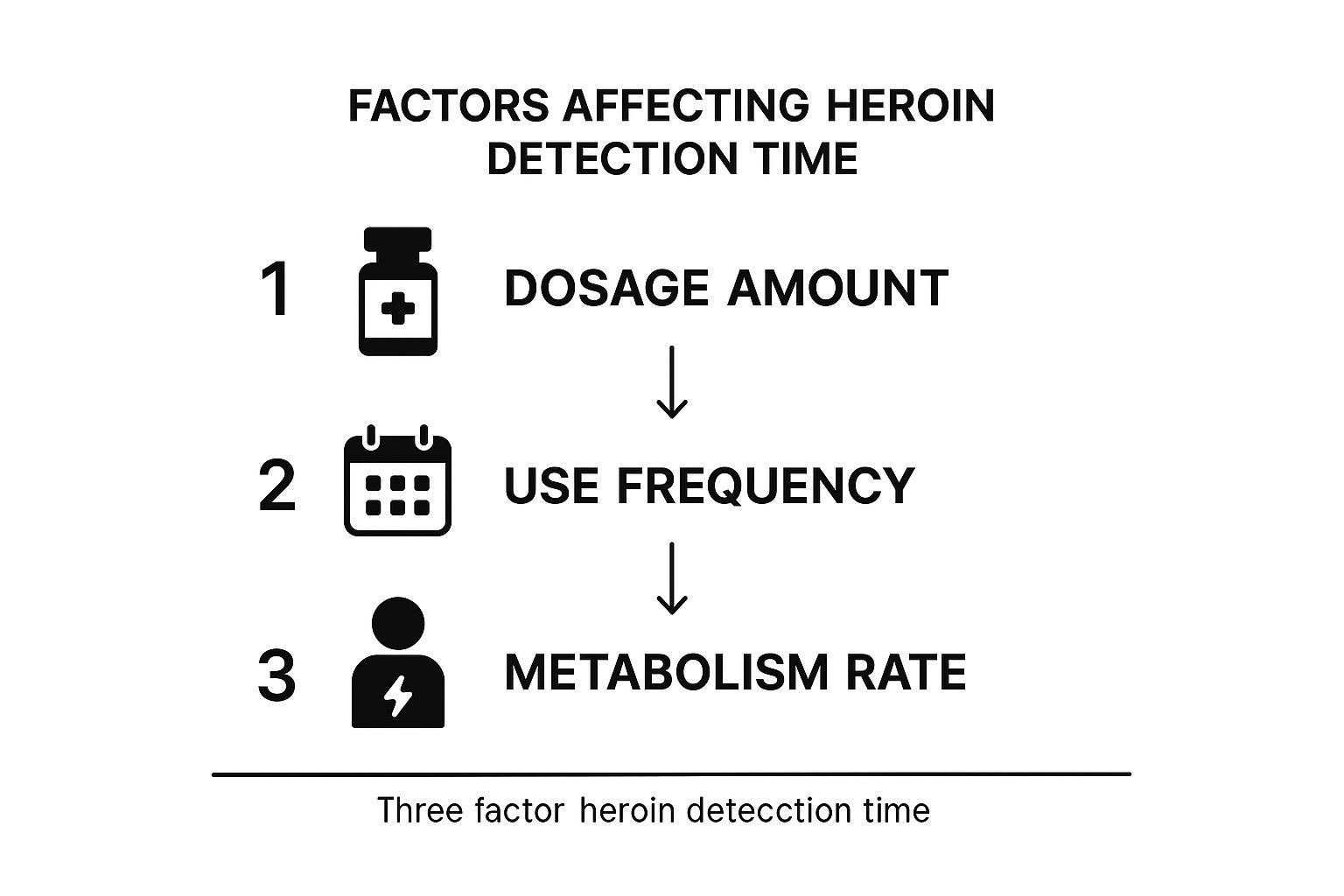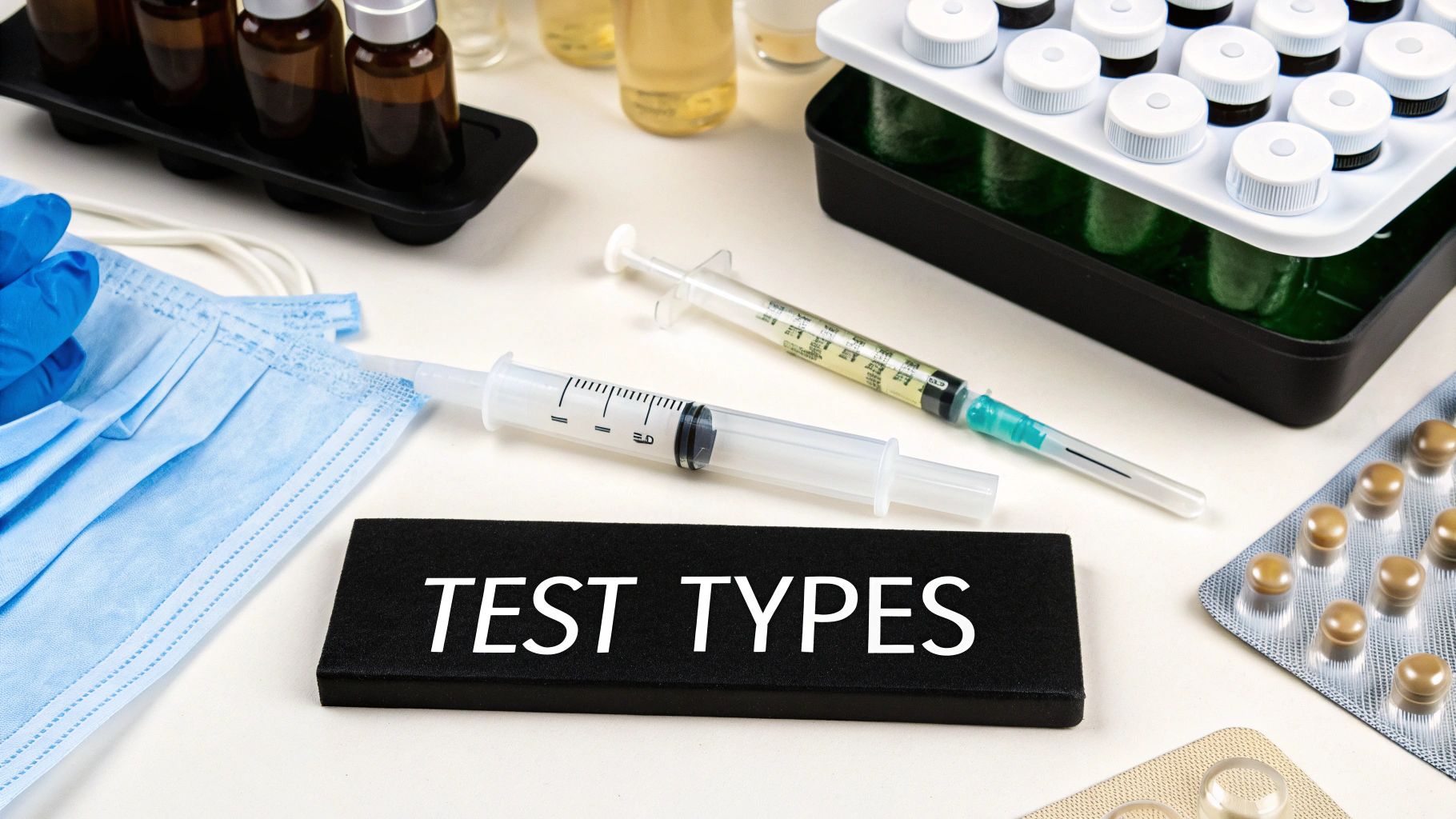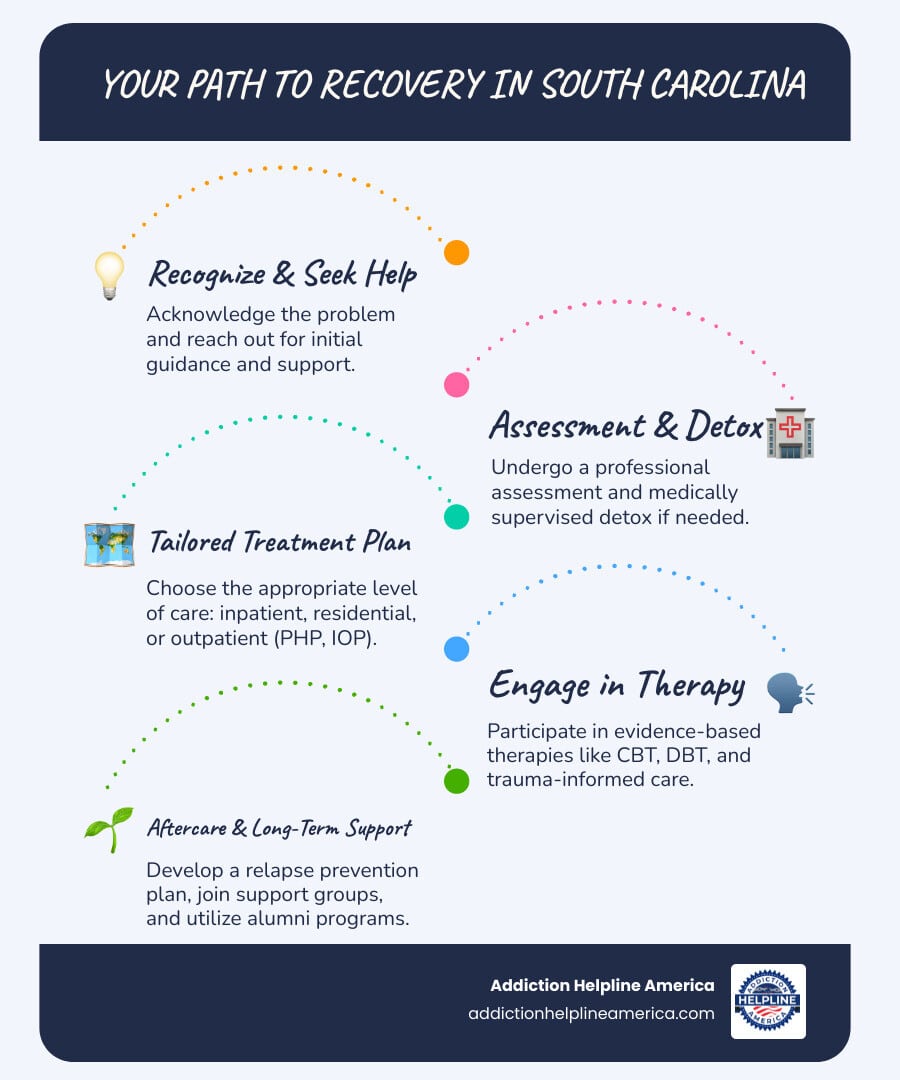
One of the most common questions we hear is, “How long does heroin stay in your system?” There’s no single, simple answer to that. The detection window isn’t a fixed number; it depends entirely on the type of test being used.
Generally, you can expect heroin’s tell-tale signs to be found in urine for up to three days. For blood or saliva, the window is much shorter just a few hours. Hair follicles, on the other hand, can hold evidence of use for 90 days or even longer. It’s also critical to remember that personal factors like your metabolism and how often you’ve used the substance can dramatically change these timelines.
Understanding Heroin Detection Timelines

When we talk about how long heroin “stays in your system,” what we’re really asking is how long it can be detected. The human body is remarkably efficient at breaking down foreign substances. Heroin itself actually has a very short half-life, which means it’s flushed from the bloodstream incredibly fast, often within just a few minutes of use.
Because it disappears so quickly, most drug tests aren’t actually looking for the heroin molecule itself. Instead, they hunt for its byproducts, which are called metabolites. Think of these as the chemical footprints heroin leaves behind as your body processes it.
There are two primary footprints that testers look for:
- 6-monoacetylmorphine (6-MAM): This is the smoking gun. It’s a unique metabolite that only comes from heroin, so its presence confirms heroin use specifically. The catch is that 6-MAM also clears out of the body pretty quickly.
- Morphine: After its initial breakdown, heroin eventually metabolizes into morphine. Since morphine sticks around in the body for a longer period, standard opiate tests are calibrated to find it.
Heroin Detection Windows by Test Type
The detection window can vary dramatically from one testing method to another. This table breaks down the typical timeframes you can expect for the most common types of drug tests.
| Test Type | Typical Detection Window |
|---|---|
| Urine Test | 1 to 3 days |
| Blood Test | Up to 6 hours |
| Saliva Test | Up to 24 hours |
| Hair Follicle Test | Up to 90 days or more |
As you can see, the method really matters. A person could easily test negative on a blood or saliva test just a day after use, yet still test positive on a urine or hair follicle test taken at the very same time.
“The key takeaway is that the type of test determines the detection window. A person could test negative on a blood test but positive on a hair test taken the same day.”
It’s crucial to understand these differences to make sense of any test results. Beyond the test type, a whole host of individual factors come into play, including the dosage used, a person’s metabolic rate, their age, body mass, and overall health. All of these influence how quickly the body can process and clear out these substances. For a deeper dive, you can learn about the science behind these tests and get more details on how long heroin stays in your system.
Call Now – Your Journey to Recovery Begins Today!

Take the first step towards a healthier life! Call now to connect with our compassionate team and start your recovery journey today. Your path to healing awaits!
Our recovery specialists are available 24/7 to provide support, and all calls are confidential and free. Reach out anytime – we’re here to help!
How Your Body Processes and Clears Heroin
Think of your body as a sophisticated chemical processing factory. When a substance like heroin is introduced, it doesn’t just hang around. Instead, your body’s systems immediately get to work, kicking off a rapid disassembly process. This metabolic journey is precisely why we can detect heroin use and is the key to understanding how long it remains in your system.
The breakdown starts almost instantly. As soon as heroin hits the bloodstream, enzymes in your liver, brain, and other tissues jump into action. They quickly convert the heroin into a very specific substance called 6-monoacetylmorphine, or 6-MAM. This first metabolite is important because it’s a unique chemical fingerprint—it only comes from heroin. But it also has a very short lifespan.
From there, the process continues. The 6-MAM is then further metabolized into a much more common and stable opiate: morphine. Since morphine sticks around in the body far longer than either heroin or 6-MAM, it’s the primary compound that most standard drug tests are calibrated to find.
The Concept of a Half-Life
To really get a handle on detection times, you need to understand the concept of a half-life. A drug’s half-life is simply the amount of time it takes for your body to process and eliminate half of the active substance. Heroin itself has an incredibly short half-life, sometimes just a few minutes.
“It’s a bit like a cup of hot coffee cooling down. It loses a good chunk of its heat fairly quickly, but it takes a much longer time to finally reach room temperature. In the same way, your body gets rid of half the drug quickly, but traces of it can hang around and stay detectable for a good while longer.”
This is why detection windows are always presented as ranges, not exact numbers. After one half-life, the initial dose is reduced by 50%. After the next half-life, the remaining amount is cut by another 50%, and so on. This gradual process is why metabolites can be found long after the drug’s noticeable effects have faded.
This infographic helps visualize how all these factors—dosage, frequency of use, and your own metabolism—interact to determine the final detection window.

As you can see, a larger dose or more frequent use essentially creates a bigger backlog for your body to work through, which directly extends how long metabolites will be detectable. Grasping this process is a crucial first step toward understanding the physical side of addiction. For anyone ready to stop using, know that many effective opioid addiction treatment options are available to provide the medical and therapeutic support needed for this challenging journey.
Understanding Each Type of Heroin Drug Test

When we talk about drug testing, it’s not a one-size-fits-all situation. The answer to “how long does heroin stay in your system?” completely depends on which test is being used. Each one is a different tool for a different job, offering a unique window into a person’s substance use.
Some tests are designed to catch drug use that happened just hours ago, while others can paint a picture of someone’s habits over several months. Think of it this way: a blood test is like a snapshot of what’s happening right now, making it perfect for an ER doctor trying to confirm an overdose. A hair test, on the other hand, is like a historical timeline, revealing patterns of use that are far more useful in a legal or long-term monitoring setting.
Urine Tests for Heroin Detection
Urine testing is the go-to method for most situations, and for good reason. It’s non-invasive, pretty affordable, and strikes a great balance between ease of use and a practical detection window.
Since urine tests look for morphine—the more stable byproduct of heroin metabolism—they can successfully spot use for up to three days after the last dose. This reliability and timeframe make it the standard choice for workplace drug programs, probation checks, and addiction treatment centers.
Blood Tests and Immediate Use
Blood tests have the shortest memory of all. Heroin and its direct metabolite, 6-MAM, disappear from the bloodstream incredibly fast. This means a blood test is only effective for a very brief period, usually no more than six hours after someone has used the drug.
This tight window makes blood tests impractical for any kind of routine screening. You’ll typically only see them used in specific, time-sensitive scenarios where confirming immediate impairment is the goal, such as:
- After a car accident to determine if a driver was actively under the influence.
- In an emergency room to diagnose a suspected overdose.
- During a post-mortem investigation to help establish the cause of death.
Saliva Tests for Recent Exposure
Saliva tests, sometimes called oral fluid tests, offer a detection window that sits somewhere between a blood and urine test. They’re gaining popularity because they’re so easy to administer on the spot and much harder to cheat than a urine sample. A saliva test can generally detect heroin metabolites for up to 24 hours after use.
This makes them a solid choice for situations that demand proof of very recent consumption, like roadside testing by law enforcement or post-accident screenings in the workplace.
“The most significant difference lies in what each test measures: Blood and saliva tests capture very recent use, urine tests cover a few days, and hair tests reveal a long-term history.”
Hair Follicle Tests for Long-Term History
If you need to look back in time, nothing beats a hair follicle test. As your hair grows, drug metabolites circulating in your bloodstream become trapped and sealed inside the hair shaft. By taking a standard 1.5-inch sample of hair from the scalp, testers can uncover a history of drug use stretching back up to 90 days.
This incredibly long detection window means hair tests are useless for figuring out if someone is impaired right now. But they are the perfect tool for establishing a long-term pattern of use or abstinence. They’re frequently used in child custody cases, screenings for high-security jobs, and to monitor compliance in long-term treatment programs. Each test has a clear purpose, which is why the why behind the test matters just as much as the result.
Call Now – Your Journey to Recovery Begins Today!

Take the first step towards a healthier life! Call now to connect with our compassionate team and start your recovery journey today. Your path to healing awaits!
Our recovery specialists are available 24/7 to provide support, and all calls are confidential and free. Reach out anytime – we’re here to help!
Personal Factors That Affect Detection Times
The type of drug test used is only one part of the equation. The other, equally important part, is you. The reason detection windows are always given as ranges is because every person’s body is unique, and a whole host of personal factors can either speed up or slow down how long heroin stays in your system.
Think of it like two people running a marathon. Even if they start at the same time and run the same course, their finish times will be different based on their training, age, and overall fitness. In the same way, two people can use the same amount of heroin but clear it from their bodies at very different rates.
Getting a handle on these individual variables is the key to understanding why there’s no single, one-size-fits-all answer. It’s a combination of your biology, your habits, and your health that creates a personal timeline.
Frequency and Dosage of Use
Right at the top of the list are the two most influential factors: how much heroin was used and how often. It’s simple, really. A one-time user will clear the drug from their system much faster than someone with a long-term, daily habit.
With chronic use, heroin metabolites start to build up in the body’s tissues, especially in fat cells. This creates a backlog that the body has to work through. A single dose might be processed and eliminated within a few days, but with frequent, heavy use, the body is constantly trying to play catch-up. This saturation effect is what really extends the detection window for all types of tests.
“A person with a history of heavy use will test positive for much longer than someone who used the drug just once. The body simply has more metabolites to clear out, prolonging the timeline.”
Metabolism and Body Composition
Your metabolic rate is basically the speed at which your body’s internal factory processes everything—including drug metabolites. Someone with a faster metabolism will naturally clear substances more quickly. This rate is influenced by a mix of genetics, age, and how physically active you are.
But that’s not all. Your body mass and fat content also play a huge role. Heroin’s metabolites are lipophilic, which is a scientific way of saying they are drawn to and can be stored in fat cells. An individual with a higher percentage of body fat may hold onto these metabolites for longer than a leaner person, as the substances are slowly released back into the bloodstream over time.
This is one of the biggest reasons why how long heroin stays in your system can vary so dramatically, even between people who seem to have a similar build.
Age and Overall Health
As we get older, our metabolism naturally starts to slow down. This means an older person’s body might take longer to process and get rid of heroin metabolites compared to a younger person’s.
However, the most critical health factors are your liver and kidney function. Think of the liver as the main processing plant for metabolizing drugs, and the kidneys as the filtration system that removes the waste from your blood and sends it to your urine.
- Liver Health: If the liver is damaged by conditions like hepatitis or cirrhosis, its ability to break down heroin into its byproducts is seriously hampered.
- Kidney Health: In the same vein, poor kidney function means the body can’t efficiently get rid of these metabolites, causing them to stick around in the system for longer.
Any problem with these vital organs can dramatically extend the detection period. This reality highlights why it’s so important to seek help, not just for the substance use itself, but for the ripple effect it has on your overall physical health. On top of that, it’s vital to be aware of the serious legal consequences of drugs in the United States, which can make these health challenges even more complicated.
Why Accurate Heroin Detection Matters
The question of how long heroin stays in your system is about so much more than just passing a test. It’s a conversation that touches on public health, personal recovery journeys, and even legal decisions. Getting detection right isn’t a minor technical detail—it’s absolutely essential for helping people navigate the challenges of substance use.
For a doctor or therapist guiding someone through recovery, accurate testing is everything. It provides a clear, honest look at where a person is in their journey. Is the treatment plan working? Is more support needed? An accurate test result helps answer these questions, ensuring the person gets the right care at the right time. This clarity builds trust and opens the door for real, productive conversations about recovery.
A Growing Public Health Concern
The urgency for reliable testing methods has grown right alongside the rise in heroin use. Over the last two decades, its presence has created a serious public health issue, particularly in the United States.
Think about this: between 2006 and 2012, the number of people trying heroin for the first time in the U.S. jumped from about 90,000 to 156,000. That’s a staggering 73% increase in just six years. This trend highlights why understanding heroin’s detection window is so critical for creating effective public health strategies. You can find more details about these trends and the complexities of heroin detection in this in-depth overview from American Addiction Centers.
“Understanding detection windows is crucial not only for individuals but also for shaping effective public health policies, allocating resources for treatment, and developing preventative education programs.”
The Legal and Personal Stakes
The impact of a drug test goes far beyond the clinic. In the legal world, a test result can change everything. For someone on probation, in a child custody case, or navigating other legal challenges, an accurate test can prove they’re committed to staying sober. On the flip side, a false positive or a misread result can cause devastating and unfair consequences.
Ultimately, this knowledge empowers everyone. It gives individuals the information they need to take control of their health, arms clinicians with the tools to provide effective care, and shows families how they can best support a loved one’s recovery.
If you’re worried about your own use or that of someone you care about, getting confidential help is an important first step. You can find compassionate support and learn about your options by reaching out to a heroin and fentanyl abuse helpline.
Where to Find Support and Credible Information

If you’re looking up information on “how long does heroin stay in your system,” chances are you’re worried—either for yourself or for someone you care about deeply. The first thing to know is that you’re not alone in this, and there is compassionate, confidential help ready and waiting.
While understanding drug detection windows is a practical first step, what truly matters is finding a path toward safety and recovery. Professional support provides a structured, judgment-free environment to do just that. The journey out of addiction is unique for everyone, but having expert guidance can make all the difference.
“Seeking help isn’t a sign of weakness; it’s a profound act of strength. It’s the bravest step you can take toward reclaiming your life or helping someone you love reclaim theirs.”
Credible Helplines and Medical Guidance
When you’re ready to talk, one of the most trusted resources is SAMHSA’s National Helpline. You can reach them anytime at 1-800-662-4357. This service is free, completely confidential, and available 24/7 to connect you with local treatment centers, support groups, and other community resources.
It’s also incredibly helpful to speak with a medical professional, like a primary care doctor or an addiction specialist. They can offer advice that’s specific to your personal health and circumstances. If you feel lost and don’t know where to start, learning how to help a drug addict can give you a clear, supportive framework for taking that next step. Your well-being is the absolute priority.
Common Questions About Heroin Detection
When it comes to drug testing for heroin, there’s often a lot of confusion and misinformation out there. Let’s clear things up by tackling some of the most frequently asked questions about how heroin is detected and for how long.
Can You “Flush Out” Heroin By Drinking a Lot of Water?
It’s a common myth that you can beat a drug test by chugging water. While it’s true that severe dehydration can concentrate your urine and make metabolites easier to spot, the reverse isn’t a foolproof strategy.
Drinking an excessive amount of water will certainly dilute your urine, but modern labs are wise to this. They test for creatinine levels and specific gravity to see if a sample is too watered-down. If it is, the sample is usually flagged as invalid, which almost always means you’ll have to take the test again. It doesn’t actually speed up the clock on how long heroin is detectable.
Why Can a Hair Test Find Heroin for So Much Longer?
Think of your hair as a historical record. As your body metabolizes heroin, the resulting byproducts travel through your bloodstream to nourish your hair follicles. Those metabolites get trapped and sealed inside the hair shaft as it grows.
“Since hair grows about half an inch per month, a standard 1.5-inch sample taken from close to the scalp can reveal a substance use history stretching back roughly 90 days. This turns your hair into a long-term timeline, unlike urine or blood tests which only offer a snapshot of very recent use.”
Call Now – Your Journey to Recovery Begins Today!

Take the first step towards a healthier life! Call now to connect with our compassionate team and start your recovery journey today. Your path to healing awaits!
Our recovery specialists are available 24/7 to provide support, and all calls are confidential and free. Reach out anytime – we’re here to help!
Do Drug Tests Look for Heroin or Morphine?
This is a great question, and the answer is usually both. Heroin itself has an incredibly short life in the body, breaking down very quickly. Because of this, standard opiate drug screens are designed to look for morphine, its more stable and longer-lasting metabolite.
However, more sophisticated tests can go a step further. They can specifically screen for 6-acetylmorphine (6-MAM), a metabolite that is 100% unique to heroin. Finding 6-MAM is concrete proof of heroin use, which is critical for ruling out other opiates like prescription morphine or codeine in clinical and legal settings.
Getting a handle on these facts is a key part of understanding the recovery journey. For those looking to connect with others who understand, checking out different support groups for addiction can be a powerful source of strength and community. You don’t have to navigate this path alone.
If you or someone you care about is struggling with alcohol or drug addiction, please know that help is available and you are not alone. Addiction Helpline America is here to connect you with experienced, compassionate professionals who can guide you through the recovery process. We have the expertise to help you take that first, crucial step toward a healthier, substance-free life. Find out more at https://addictionhelplineamerica.com.
Our helpline is 100%
free & confidential
If you or someone you care about is struggling with drug or alcohol addiction, we can help you explore your recovery options. Don’t face this challenge alone—seek support from us.
Programs
Resources
Will my insurance
cover addiction
treatment?
We're ready to help
Find the best
drug or alcohol treatment
center
Are you or a loved one struggling with addiction? Call today to speak to a treatment expert.
















